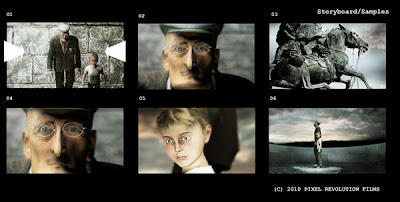When working out how to bring a scene to life, we start with an idea and then it’s to the drawing board. Storyboards not only help us bring a scene to life, but they also help us foresee any potential problems. Of course, having a storyboard on set also helps convey your vision of a particular scene to crew and cast members much easier than just relying on trying to describe it.
There are a few specialised software out there for producing storyboards, such as Frameforge’s Previz.
But we mainly use Poser from SmithMicro, Iclone from RealIllusion and our beloved PhotoShop to create our artwork.
The storyboards below were created using Poser and PhotoShop.
We also use storyboards to help work out the colour palette for a film. Below are examples of storyboards where we have experimented with colour grading techniques.
Sometimes, if time constraints are really tight, we might rely on a shot list instead, with the ideas for the actual shot worked out in our minds, the shot list acts as a check list that we can cross off as we go along, ensuring we don’t miss a valuable shot, as can easily happen with you’re working against the clock on a shoot.
It would be wrong to say we adhere absolutely rigidly to storyboards when we film, because we also love to shoot intuitively too, but having the storyboards in place allows us the freedom to be able to experiment more when filming and ensures we’ll get the shots that we really need.
Storyboards are an essential part of preparing for a shoot and will help ensure things run as smoothly as possible.
A typical sight on one of our sets.




